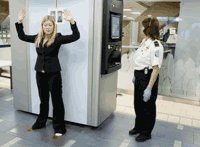As more attention focuses on nearly-naked airport scanners, scientists are debating the safety of the technology. Two different technologies are at work in the scanners now in use at 68 U.S. airports. Millimeter wave scanners employ radio waves, a low-energy version of how data reaches cellphones and microwave ovens heat food. Such scanners use electromagnetic radiation, not ionizing radiation, and thus aren’t controversial.Backscatter X-ray technology, on the other hand, is in about 40 percent of the 385 airport scanners nationwide and is the focus of debate. Through a process called Compton scattering, X-ray photons are bounced off the skin, returning to a detector at different strengths depending on the types of atoms they encounter. The narrow X-ray beams sweep back and forth quickly across the body, allowing the machine to “see” a difference between flesh, metal, liquid and some powders, all in a matter of seconds.Read more from Palm Beach Post.
Are Airport Scanners Safe?





